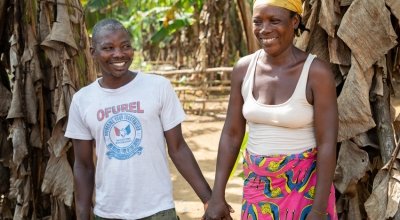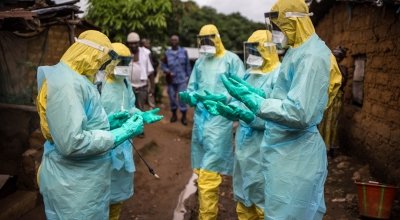
Read our 2023 annual report

Knowledge Hub
World Food Day: good recipes for a healthy body from Sierra Leone
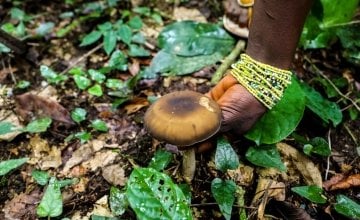
To combat hunger, communities in Sierra Leone are turning to the fruits of their forests to supplement their diets and ensure they are consuming a diverse range of nutritious foods. Here, we share their recipe for a nourishing local dish.
Celebrating World Food Day
Today is World Food Day and for many of us this may be no big deal. We have fast, convenient access to food whenever we need it, particularly for those of us living in cities and urban areas. We have cuisines from around the world at our fingertips – sometimes just a phone call away.
But for the 815 million people around the world who go hungry, today is a big deal. It promotes worldwide awareness and action for their suffering and it presses the need to ensure food security and nutritious diets for everyone. It is also a day for us to celebrate the progress we have already made in reducing hunger around the globe as we push towards zero hunger by the year 2030.
Despite making progress in recent years, Sierra Leone continues to bear a significant burden of hunger. According to the 2017 Global Hunger Index, alarming levels of hunger are persisting in a country which is still recovering from the recent Ebola epidemic. Geographical, gender and socio-economic inequalities all contribute to the problem so the solution requires a variety of approaches. They need to adapt to the local context, make the most of available resources and most importantly, work for the communities they are targeting.
Linking Agriculture and Natural resources for Nutrition
Launched in Sierra Leone in 2013 by Concern Worldwide and Welthungerhilfe, the Linking Agriculture and Natural Resource Management towards Nutrition Security (LANN) programme adopts a multi-sectoral approach to nutrition. The programme recognises the link between hunger and inequality and attempts to tackle both through the more targeted use of locally available resources.
In addition to focusing on clean water, sanitation and hygiene and diversified agricultural practices and nutrition education, this programme also includes the promotion of wild foods to supplement nutrition during lean periods. Communities are shown how to identify nutrient-rich wild foods in the forest that are safe to eat.
They are also given training in how to cook these foods without losing the valuable nutrients. Known in Krio as ‘Good Chop na Well Body’, meaning ‘good recipes for a healthy body’, we were recently lucky enough to receive a community demonstration which we share with you here for World Food Day.
Ingredients
For this recipe you will need:
- Water
- Salt
- A dash of palm oil (but not too much) or White oil (a healthier supplement to the palm oil)
- Garden eggs (alternatively known as aubergine … or eggplant)
- Okra; Cassava (fermented)
- Leafy green forest veg
- Chilli peppers
- Ground nuts
- Foo-Foo
- Rice
- Chicken (or any other fowl)
- Fish
- Bush meat (squirrel)
- Giant snails
- Chicken stock cubes
Depending on where you live, some of these ingredients may not be readily available. You can substitute with local ingredients but you’ll have to gather some tools, head to the trees and get foraging...
Gathering the finest quality ingredients
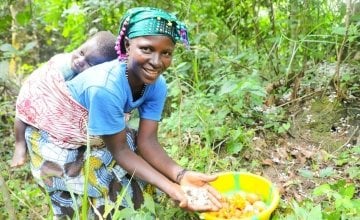
On a hot day in Sierra Leone, community members gather together in Maconteh Sampha village, preparing to head into the forest to collect the last of the ingredients for their weekly food plans. Spirits are high and there’s chatter and laughter as everyone sets off down a small dirt track towards the trees.
The men carry machetes, slashing back the bushes to clear the path for everyone else. Others carry mattocks, spades or sticks – useful tools for digging or reaching high into the trees. Once inside the thick, dense overgrowth, the air becomes noticeably cooler and everyone immediately gets to work seeking out what nature has to offer.
First up are giant snails – these are not your average garden variety snail but huge molluscs the size of a fist. Only found in west Africa, the best way to spot them is to look for leafy plants on the ground where you are sure to find them nibbling.
Next up is bush yams – the spades come out for these as you have to dig fairly deep to unearth them. Bush yams resemble long tubers, not dissimilar to a long Jerusalem artichoke (if you know what that looks like).
Then it’s onto the fruits, of which there is a plentiful array that is ripe for the picking. There are ‘therma berries’, a sweet orange fruit that looks like a mini-peach the size of a Malteaser. Moving up in size is the ‘malumbo’, another orange fruit, this time the size of a golf-ball – very sweet and very nutritious. Amidst all the exotic fruits are some plain old pineapples and mangos. And then there is an eye-catching star-shaped fruit known locally as ‘rath fingers’. The fingers peel away to expose a berry the size of a bead at the centre – the only part of the fruit that is actually edible. Some of the women are harvesting bot-bot, sweet orange-green berries from a bush that looks like a tree. Others are climbing up high and using sticks to reach the palm fruit, which are small berries, reddish in colour.
Back on the forest floor, people are picking ‘magbinte’ mushrooms which resemble large chanterelle mushrooms. And traps are being laid to catch bush-meat, typically squirrels or similar woodland creatures. And all around are wild vegetables, packed full of green leafy goodness.
If you know what you’re looking for, the forest can offer up a wealth of nutritious foods. But while foraged food might be considered the height of cuisine in some countries, in Sierra Leone there can be a stigma attached to the activity as it is perceived as a sign of poverty to forage for your food. Thanks to some guidance from Concern and Welthungerhilfe, this community are overcoming that stigma, and more importantly, they know exactly what foods to look for to bring a diverse variety of nutrients into their diets.
Lessons in cooking
After gathering such fine ingredients, it is crucial to know how to cook them without losing their vital nutrients. The community members gather back in the village to prepare their meal together under the guidance of the LANN programme officers.
First up is a brief refresher training from the programme staff for the men of the village on how they can help to ensure the good nutrition of their family. And then it’s on to the cooking.
When preparing a meal of this size for the whole community it’s a case of ‘many hands make light work’ rather than ‘too many cooks spoil the broth’. This is a communal effort and the busy hum of activity descends once again on the village as everyone gets stuck in.
The meal prep centres around three large pots and small groups form around each one. As with any good cookery class, some of the ingredients were prepared earlier.
The garden eggs are chopped and added to the first pot, quickly followed by okra (already pounded). Delicious aromas start to fill the air as water is added to cassava (already fermented AND pounded) so it rolls up into little balls. Cassava can also be boiled but this method better preserves the nutrients of the vegetable.
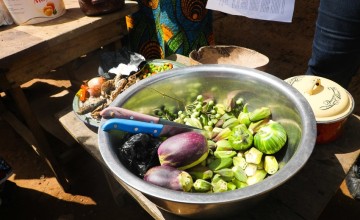
Meanwhile, a man and woman are working together to pound groundnuts, which will eventually be added to the stew in the second pot.
Back at the first pot, the chicken is being added to the okra and the aubergines, along with a dash of palm oil - only a dash though, as programme staff are eager to remind everyone that palm oil is bad for your heart and should be substituted, where possible, with white oil. The dash of palm oil is more for flavour than for cooking necessity.
Although nutrition is the top priority, no-one is forgetting about flavour and it is clearly with this in mind that a mountain of chilli peppers (pounded, of course) are added to the second pot where a pile of rice and some bush meat (in this case, squirrel) and giant snails are already on the boil. The groundnuts, pounded into a paste by now, are added to the leafy green forest vegetables and these get added into the mix. These are followed by fish, for extra protein and then a dash of burnt palm oil for that all important flavour.
Over at the third pot, one woman has patiently been preparing the Foo-Foo. Already fermented, (and pounded!) by her husband, she is now stirring it steadily as water is added. The water evaporates and the Foo-Foo begins to solidify to just the right consistency to roll the mix into balls. A little salt is added for flavour and the stirring never lets up to ensure that the mix does not stick to the pot. It’s hot and heavy work and her husband pitches in with a large wooden spoon.
Back at the first pot, the remaining chilli peppers are added and finally, a small pinch of salt is added as the cooking draws to a close. Then it’s time to serve up!
“Now we are actually happy”
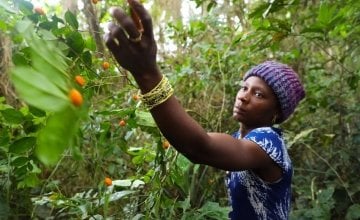
Hawa Kamara is one of the women taking part in the cooking demonstration and she is full of praise for the LANN programme.
“When this programme started we had nothing. Then they trained us on how we should work, how we should do our business, what to eat, what to sell, how we should sell, and we followed that”, she says.
Talking specifically about the nutrition aspect of the programme, she continues “Before, we used to just concentrate on eating rice, but now we do not continuously eat it. We have diversified our food. We interchange. We eat rice today, we eat corn tomorrow, we eat cassava the next day. That has helped our health”.
“Now we are actually happy in our community”, she concludes.
Adamsay Kargbo, also taking part in the days activities, agrees that the programme has helped her family and her community.
“The programme has really benefitted us. We planted rice, we planted corn, we planted groundnuts, and then we harvested it. We also eat food now that we used to neglect, like the wild food”, she says.
She finishes by adding, “we are all very happy with Concern’s presence here”.
Hunger around the world
You can find out more about the state of hunger in Sierra Leone and around the globe, by downloading the 2017 Global Hunger Index.



